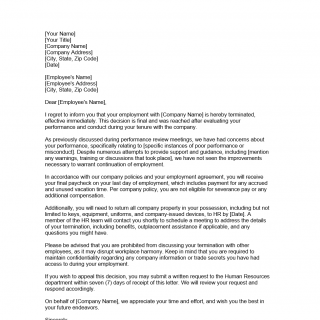Firing Letter
A firing letter is a document that an employer uses to formally terminate an employee's employment due to poor performance, misconduct, or other reasons that are within the employee's control. The letter typically explains why the employee is being terminated, what the employee's final pay and benefits will be, and any other relevant information, such as how to appeal the decision.
The firing letter typically consists of the following parts:
- Date: The date on which the letter is written.
- Employee Name: The name of the employee being terminated.
- Employee Address: The address of the employee being terminated.
- Company Name and Address: The name and address of the company terminating the employee.
- Salutation: A formal greeting addressing the employee by name.
- Introduction: A statement that the purpose of the letter is to formally terminate the employee's employment.
- Reason for Termination: A description of the reason(s) for the employee's termination.
- Final Pay and Benefits: A statement outlining the employee's final pay and benefits.
- Return of Company Property: A statement instructing the employee to return any company property.
- Information on Appeals: A statement providing information on how to appeal the decision, if applicable.
- Signature: The signature of the person writing the letter.
- Contact Information: Contact information for the company, including a phone number and email address.
The most important fields in a firing letter are the reason for termination and the final pay and benefits. These are the two pieces of information that the employee will likely be most concerned about.
The firing letter is compiled when an employer needs to formally terminate an employee's employment due to poor performance, misconduct, or other reasons that are within the employee's control. The parties to the document are the employer and the employee being terminated.
When compiling a firing letter, it is important to consider the tone of the letter. The letter should be professional and respectful, even if the employee's termination is due to poor performance or misconduct. It is also important to be clear and concise in the letter, providing all necessary information without going into unnecessary detail.
Firing Letter Sample
[Your Name]
[Your Title]
[Company Name]
[Company Address]
[City, State, Zip Code]
[Date][Employee's Name]
[Employee's Address]
[City, State, Zip Code]Dear [Employee's Name],
I regret to inform you that your employment with [Company Name] is hereby terminated, effective immediately. This decision is final and was reached after evaluating your performance and conduct during your tenure with the company.
As previously discussed during performance review meetings, we have had concerns about your performance, specifically relating to [specific instances of poor performance or misconduct]. Despite numerous attempts to provide support and guidance, including [mention any warnings, training or discussions that took place], we have not seen the improvements necessary to warrant continuation of employment.
In accordance with our company policies and your employment agreement, you will receive your final paycheck on your last day of employment, which includes payment for any accrued and unused vacation time. Per company policy, you are not eligible for severance pay or any additional compensation.
Additionally, you will need to return all company property in your possession, including but not limited to keys, equipment, uniforms, and company-issued devices, to HR by [Date]. A member of the HR team will contact you shortly to schedule a meeting to address the details of your termination, including benefits, outplacement assistance if applicable, and any questions you might have.
Please be advised that you are prohibited from discussing your termination with other employees, as it may disrupt workplace harmony. Keep in mind that you are required to maintain confidentiality regarding any company information or trade secrets you have had access to during your employment.
If you wish to appeal this decision, you may submit a written request to the Human Resources department within seven (7) days of receipt of this letter. We will review your request and respond accordingly.
On behalf of [Company Name], we appreciate your time and effort, and wish you the best in your future endeavors.
Sincerely,
[Your Name]
[Your Title]
The advantages of using a firing letter are that it provides a formal record of the termination, which can be important in the event of a legal dispute. The letter also ensures that the employee is aware of the reason for their termination and any final pay and benefits that they are entitled to.
The main problem that can arise when filling out a firing letter is that the employer may inadvertently include information that could be used against them in a legal dispute. It is important to consult with a legal professional when drafting a firing letter to ensure that it is legally sound.
Related forms and alternative forms to a firing letter include a warning letter, which is used to inform an employee that their performance is not meeting expectations and that further disciplinary action may be taken if the performance does not improve. An alternative form to a firing letter is a resignation letter, which is used when an employee voluntarily resigns from their position.
The main difference between a firing letter and a layoff letter is that a firing letter is used when the termination is due to poor performance, misconduct, or other reasons that are within the employee's control, while a layoff letter is used when the termination is due to business reasons that are outside of the employee's control.
The firing letter should be submitted to the employee in person or via certified mail, with copies kept on file by the employer. It is important to keep copies of all termination-related documents in case they are needed in the future.

